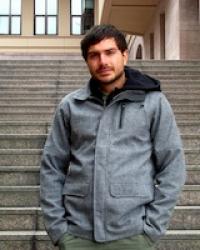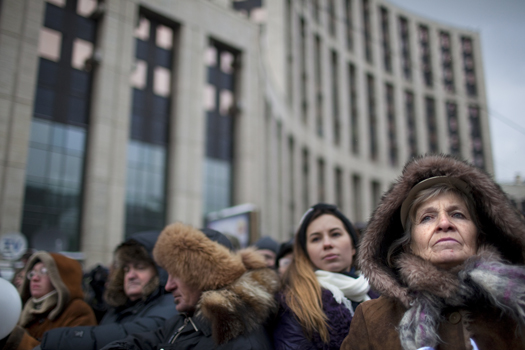
Demonstrators gather on Academician Sakharov Avenue in Moscow to protest the December 4 parliamentary elections, which they claim were rigged. Vladimir Putin, whose party won the vote, denies the charge. (Maisie Crow)
Moving my feet felt like lifting blocks of concrete. My toes had gone numb, but my soles burned and throbbed with every step. The gray Moscow slush had found a way to seep through my boots and two pairs of socks. Next to me, a man dressed as Ded Moroz—Father Frost, the Russian equivalent of Santa Claus—seemed immune to the cold. He puffed away on a cigarette, apparently unconcerned about the flammability of his bushy nylon beard. The demonstration was coming to an end, and another Ded Moroz appeared on stage to wish the protesters a happy and free 2012. “Impostor!” the smoking Ded Moroz hollered from the crowd.
Some three hours earlier, thousands of protesters had poured out of the nearest metro. They walked past three train stations, startling some commuters and annoying others. Initially, the organizers had been worried that the entrance to the demonstration—there was only one, punctuated by dozens of metal detectors—would be hard to find; maps were posted and reposted on numerous websites. In reality, it was impossible to get lost: a flood of people moved toward the avenue without hesitation, as though guided by some internal compass.
Despite a military helicopter’s ominous whirring overhead, the mood was light-hearted and festive. As I passed through one of the metal detectors and received an obligatory pat down, the policewoman (law enforcement mandated same-gender frisking) joked with me about fashion. Large garbage bins by the entrance held a couple of flagstaffs, but the police did not show any particular interest in confiscating banners or protest signs. Organizers were freely handing out white ribbons, balloons, and flyers.
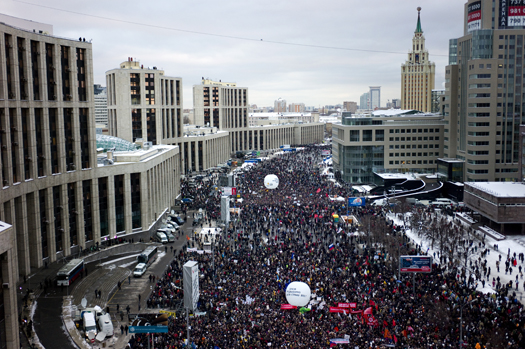
Protesters later estimated that 120,000 people gathered along Academician Sakharov Avenue. The government insists that the number was 29,000. (Maisie Crow)
A few minutes after the protest’s start at two o’clock, there was still space by the entrance. People did not seem to rush toward the stage at the other end of the avenue; powerful loudspeakers transmitted what was said on stage all along the street. “If the president doesn’t do it to his wife, he will do it to his country,” a speaker quipped. I could not put a face to the mocking voice; there was no way to see the stage.
Unlike Bolotnaya Square where a protest was held two weeks ago, Academician Sakharov Avenue, where yesterday’s protest was held, is completely flat, with no vantage points. On one side, the avenue is framed by semicircular buildings. The architecture circumscribed the crowd, isolating it from the surrounding streets and virtually ensuring that no passersby would accidentally stumble onto the demonstration. At Bolotnaya the protest had spilled out into the city at large, overflowing onto bridges and side streets, but here the demonstration was contained by its topography, which cut it off from the rest of Moscow and gave it the feel of a well-organized open-air festival. This sense was only reinforced by the carnival atmosphere: a man dressed as an animal trainer stood on a makeshift wooden platform over a poster that, in reference to a popular joke comparing the Central Election Committee to a circus, declared, “Putin, sit!”
Less than a half-hour into the protest, the avenue was completely packed. Later, opposition leaders would say that 120,000 people had attended the demonstration. (The government scoffed at this count.) Whatever the number, squeezing through the crowd, with people standing shoulder to shoulder, was no small feat. But everyone joked and laughed, kidding with each other as they tried to get through. Closer to the stage, the crowd was more politically divided. As I made my way from one side of the avenue to the other, I got stuck among nationalists, whose chants were deafeningly loud. There was a sea of black and yellow flags above my head.
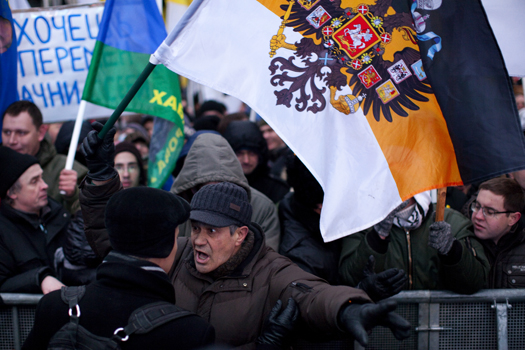
A nationalist, carrying the black and yellow Imperial Russian flag, yells at protesters. (Maisie Crow)
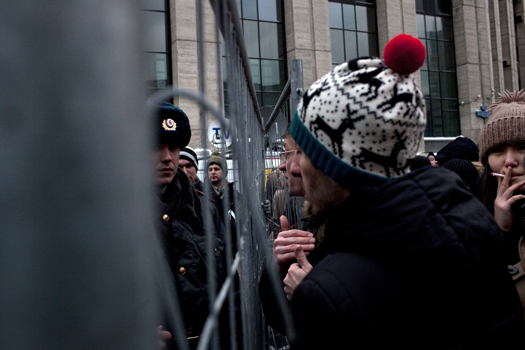
Protesters argue with police through a barricade. (Maisie Crow)
Political factions positioned themselves according to directions; the further left I moved, the more liberal the banners around me became. A gust of wind pushed a green flag, which I assumed belonged to the environmentalists, into my face. As I struggled to free myself from it, I glimpsed a rainbow banner stretching behind me. There was almost no breathing room at the very edge of the avenue, which took me a half hour to reach. Protesters were leaning on each other. A man in his sixties, pushed up against a metal divider, seemed to resign himself to not being able to see anything but people’s backs; a bewildered stray dog tried to get a better view from behind the barricade, but settled on curling up in the snow.
Yesterday, the crowd was more diverse than that at Bolotnaya. The metal fence in front of the stage was lined almost exclusively by people in their fifties or older; grandmothers posed willingly for photographers, talking to them in between speeches from the stage. The crowd’s senior members were somewhat baffled by an impassioned hip-hop performance later in the day, but it looked like the opposition leaders, who lined the perimeter of the stage (shifting from one foot to the other in an attempt to stay warm), enjoyed it. At other times, attendees had not hesitated to hiss anyone on stage with whom they disagreed—revealing not only the differences between those who spoke (from socialites to prisoners of conscience) but also the political divisions among those in the crowd.

The turnout of citizens both young and old made the Christmas Eve rally the largest opposition gathering in modern Russia. (Maisie Crow)

A member of the press corps captures the scene on an iPad. (Maisie Crow)
Toward the end of the demonstration, two flag-waving, chanting nationalists—one wearing an Astrakhan hat—broke through a metal barricade and climbed atop a platform reserved for the media. The speakers on stage were appalled, calling upon the police, who had looked profoundly bored throughout the protest, to restore order. After the platform was pulled out from under the trespassers, the two were surrounded by a swarm of photographers and cameramen. Above this scene, journalists on a rickety fire truck ladder—rented out to the media, admission fee a few hundred rubles per person—were taking photographs of the protest from above, having stood in line for over an hour to get to a good vantage.

A man stands draped in a Russian flag at the end of an anti Putin rally. (Maisie Crow)

Aided by a walker, an elderly woman leaves Saturday’s rally. (Maisie Crow)
As it got darker, a little after five o’clock, the demonstrators began to disperse. Others lined up to get a cup of free tea from a table set up by the Ministry of Emergency Situations. It was unclear whether there would be more speeches after Ded Moroz had been given a white ribbon and made a member of the opposition. Then, the day’s final resolutions were read; the seventh and final resolution appealed to the citizens of Russia not to give Putin a single vote in the presidential elections in March. “Yes or no?” the speaker asked. There was a momentary pause, as the crowd, numbed by the cold, considered the proposal. A few seconds later, a resounding “Yes!” swept through the avenue.


